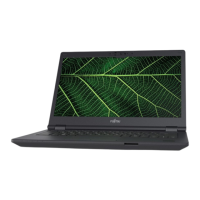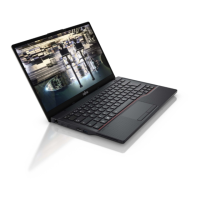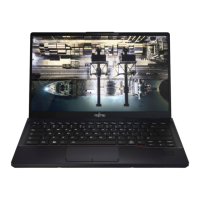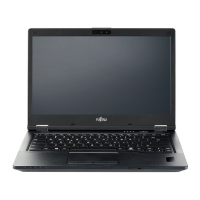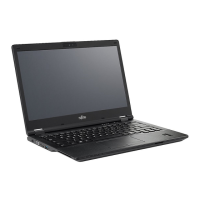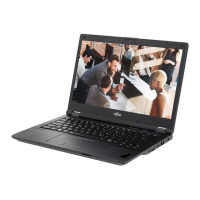Do you have a question about the Fujitsu LIFEBOOK E5413 and is the answer not in the manual?
Details and resources for product information and software drivers.
Explanation of symbols, fonts, and key conventions used in the manual.
Identification of ports and status indicators on the notebook's front.
Description of ports located on the left side of the notebook.
Description of ports located on the right side of the notebook.
Description of ports located on the rear panel of the notebook.
Description of ports and features located on the bottom of the notebook.
Essential safety information for handling the notebook and preventing hazards.
Safety rules for using wireless LAN, Bluetooth, and LTE components.
Guidance for safe travel, transport, and operation in different countries.
Instructions for cleaning the notebook and handling accidental liquid spills.
Steps for unpacking the device and checking for transport damage.
Procedure for connecting the mains adapter and powering on for the first time.
Understanding status lights and basic power controls like on/off buttons.
Details on keyboard layout, function keys, numeric keypad, and special keys.
Guide to using the touchpad, buttons, and touchscreen gestures.
Information on battery care, charging, and utilizing power saving features.
Procedure for inserting and removing the nano SIM card.
Switching wireless components on/off and setting up WLAN access.
Connecting to a local network using Ethernet LAN ports.
Description of the port replicator and how to connect/disconnect the notebook.
Configuration and use of fingerprint and palm vein sensors for authentication.
Setting up supervisor, user, and boot passwords in BIOS for system security.
Procedures for assigning, changing, and removing BIOS passwords.
Securing system startup and hard drive access with passwords.
Using SmartCards for security and the Kensington lock for physical theft prevention.
How to connect external monitors via HDMI, VGA, and display ports.
Connecting USB devices, including Thunderbolt 4 and Anytime USB charge ports.
Connecting headsets, headphones, and microphones to the audio port.
Steps to start, operate, and exit the BIOS Setup Utility.
Procedure for securely deleting data from storage devices using the BIOS utility.
Initial actions to take when a fault occurs and contacting support.
Methods for recovering data from DVDs or restoring the system in Windows.
Resolving display, input, network, and startup problems.
Understanding and resolving common BIOS error messages.
Details on operating temperature, dimensions, and weight.
Technical data for rechargeable batteries and mains adapters.
Information on product disposal, recycling, TCO, and SAR compliance.
